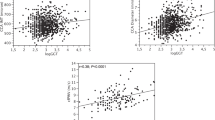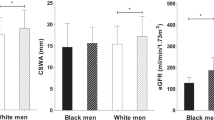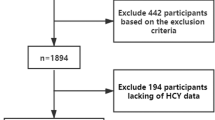Abstract
Endothelin-1 (ET-1) and oxidative stress are involved in the development of hypertension-induced cardiovascular complications. The aim of this study was to evaluate the relationship between plasma ET-1 level and plasma antioxidant capacity and carotid atherosclerosis. In 61 treated patients with hypertension (44 women, 35 diabetics, mean age 72.4±7.2 years) medical histories, ambulatory blood pressure, blood tests (glucose, creatinine, cholesterol, haemoglobin A1c (HbA1c), ET-1) and common carotid artery intima–media thickness (CCA-IMT) measurement were carried out. Plasma antioxidant capacity was assessed by the ferric-reducing ability of plasma (FRAP). Subjects with diabetes presented with higher concentrations of glucose (7.01±2.3 vs 5.14±0.6 mmol l−1, P<0.001), HbA1c (7.75±2.1 vs 6.1±1.2%, P<0.001) and ET-1 (1.36±0.53 vs 1.01±0.4 pg ml−1, P<0.01), and lower cholesterol level (5.02±0.8 vs 5.86±1.3 mmol l−1, P<0.01). A significant positive correlation between CCA-IMT and ET-1 plasma concentration (r=0.40, P<0.001) and reverse relationship between CCA-IMT and FRAP (r=−0.36, P<0.01) was observed. In a stepwise regression analysis, after adjustment for all confounders, CCA-IMT was independently influenced by age, systolic blood pressure (SBP), HbA1c and ET-1. When FRAP was included in the regression model, CCA-IMT was significantly influenced by age, FRAP, HbA1c and SBP. ET-1 promotes the increase in CCA-IMT contributing to the development of end-organ damage. Plasma antioxidant capacity may modulate this deleterious effect, but whether better antioxidant defence may prevent against the development of atherosclerosis remains to be elucidated.
This is a preview of subscription content, access via your institution
Access options
Subscribe to this journal
Receive 12 digital issues and online access to articles
$119.00 per year
only $9.92 per issue
Buy this article
- Purchase on Springer Link
- Instant access to full article PDF
Prices may be subject to local taxes which are calculated during checkout


Similar content being viewed by others
References
Haynes WG, Webb DJ . Endothelin as a regulator of cardiovascular function in health and disease. J Hypertens 1998; 16: 1081–1098.
Taddei S, Viridis A, Ghiadoni L, Sudano I, Magagna A, Salvetti A . Role of endothelin in the control of peripheral vascular tone in human hypertension. Heart Fail Rev 2001; 6: 277–285.
Iglarz M, Clozel M . Mechanisms of ET-1-induced endothelial dysfunction. J Cardiovasc Pharmacol 2007; 50: 621–628.
d’Uscio LV, Barton M, Shaw S, Lüscher TF . Endothelin in atherosclerosis: importance of risk factors and therapeutic implications. J Cardiovasc Pharmacol 2000; 35 (Suppl 2): S55–S59.
Vanhoutte PM, Shimokawa H, Tang EHC, Feletou M . Endothelial dysfunction and vascular disease. Acta Physiol 2009; 196: 193–222.
Yoshizumi M, Kim S, Kagami S, Hamaguchi A, Tsuchiya K, Houchi H et al. Effect of endothelin-1 (1–31) on extracellular signal-regulated kinase and proliferation of human coronary artery smooth muscle cells. Br J Pharmacol 1998; 125: 1019–1027.
Chen S, Khan ZA, Karmazyn M, Chakrabarti S . Role of endothelin-1, sodium hydrogen exchanger-1 and mitogen activated protein kinase (MAPK) activation in glucose-induced cardiomyocyte hypertrophy. Diabetes Metab Res Rev 2007; 23: 356–367.
Cheng TH, Shih NL, Chen CH, Lin H, Liu JC, Chao HH et al. Role of mitogen-activated protein kinase pathway in reactive oxygen species-mediated endothelin-1-induced beta-myosin heavy chain gene expression and cardiomyocyte hypertrophy. J Biomed Sci 2005; 12: 123–133.
Motte S, McEntee K, Naeije R . Endothelin receptor antagonists. Pharmacol Ther 2006; 110: 386–414.
Böhm F, Ahlborg G, Johansson BL, Hansson LO, Pernow J . Combined endothelin receptor blockade evokes enhanced vasodilatation in patients with atherosclerosis. Arterioscler Thromb Vasc Biol 2002; 2: 674–679.
Barton M, Haudenschild CC, d’Uscio LV, Shaw S, Münter K, Lüscher TF . Endothelin ETA receptor blockade restores NO-mediated endothelial function and inhibits atherosclerosis in apolipoprotein E-deficient mice. Proc Natl Acad Sci USA 1998; 24: 14367–14372.
Amiri F, Viridis A, Neves MF, Iglarz M, Seidah NG, Touyz RM et al. Endothelium-restricted overexpression of human endothelin-1 causes vascular remodeling and endothelial dysfunction. Circulation 2004; 110: 2233–2240.
Li L, Fink GD, Watts SW, Northcott CA, Galligan JJ, Pagano PJ et al. Endothelin-1 increases vascular superoxide via endothelin A-NADPH oxidase pathway in low-renin hypertension. Circulation 2003; 107: 1053–1058.
Kähler J, Mendel S, Weckmüller J, Orzechowski HD, Mittmann C, Köster R et al. Oxidative stress increases synthesis of big endothelin-1 by activation of the endothelin-1 promoter. J Mol Cell Cardiol 2000; 32: 1429–1437.
Kähler J, Ewert A, Weckmüller J, Stobbe S, Mittmann C, Köster R et al. Oxidative stress increases endothelin-1 synthesis in human coronary artery smooth muscle cells. J Cardiovacs Pharmacol 2001; 38: 49–57.
Wedgwood S, Dettman R, Black SM . ET-1 stimulates pulmonary arterial smooth muscle cell proliferation via induction of reactive oxygen species. Am J Physiol Lung Cell Mol Physiol 2001; 281: L1058–L1067.
Skalska A, Pietrzycka A, Stêpniewski M . Correlation of endothelin 1 plasma levels with plasma antioxidant capacity in elderly patients treated for hypertension. Clin Biochem 2009; 42: 358–364 (doi: 10.1016/j.clinbiochem.2008.11.002).
Benzie IFF, Strain JJ . The ferric reducing ability of plasma (FRAP) as a measure of ‘antioxidant power’: the FRAP assay. Anal Biochem 1996; 239: 70–76.
Levey AS, Bosch JP, Lewis JB, Greene T, Rogers N, Roth D et al. A more accurate method to estimate glomerular filtration rate from serum creatinine: a new prediction equation. Ann Int Med 1999; 130: 461–470.
Katona E, Settakis G, Varga Z, Paragh G, Bereczki D, Fülesdi B et al. Target-organ damage in adolescent hypertension. Analysis of potential influencing factors, especially nitric oxide and endothelin-1. J Neurol Sci 2006; 247: 138–143.
Orio Jr F, Palomba S, Cascella T, De Simone B, Di Biase S, Russo T et al. Early impairment of endothelial structure and function in young normal-weight women with polycystic ovary syndrome. J Clin Endocrinol Metab 2004; 89: 4588–4593.
Migdalis IN, Kalogeropoulou K, Iiopoulou V, Varvarigos N, Karmaniolas KD, Mortzos G et al. Progression of carotid atherosclerosis and the role of endothelin in diabetic patients. Res Commun Mol Pathol Pharmacol 2000; 108: 27–37.
Kalogeropoulou K, Mortzos G, Migdalis IN, Velentzas C, Mikhailidis DP, Georgiadis E et al. Carotid atherosclerosis in type 2 diabetes mellitus: potential role of endothelin-1, lipoperoxides, and prostacyclin. Angiology 2002; 53: 279–285.
Minami S, Yamano S, Yamamoto Y, Sasaki R, Nakashima T, Takaoka M et al. Associations of plasma endothelin concentration with carotid atherosclerosis and asymptomatic cerebrovascular lesions in patients with essential hypertension. Hypertens Res 2001; 24: 663–670.
Ihling Ch, Szombathy T, Bohrmann B, Brockhaus M, Schaefer HE, Loeffler BM . Coexpression of endothelin-converting enzyme-1 and endothelin-1 in different stages of human atherosclerosis. Circulation 2001; 104: 864–869.
Kyaw M, Yoshizumi M, Tsuchiya K, Kirima K, Suzaki Y, Abe S et al. Antioxidant inhibit endothelin-1 (1–31)-induced proliferation of vascular smooth muscle cells via the inhibition of mitogen-activated protein (MAP) kinase and activator protein-1 (AP-1). Biochem Pharmacol 2002; 64: 1521–1531.
Duerrschmidt N, Wippich N, Goettsch W, Broemme HJ, Morawietz H . Endothelin-1 induces NAD(P)H oxidase in human endothelial cells. Biochem Biophys Res Commun 2000; 269: 713–717.
Böhm F, Settergren M, Pernow J . Vitamin C blocks vascular dysfunction and release of interleukin-6 induced by endothelin-1 in humans in vivo. Atherosclerosis 2007; 190: 408–415.
Stocker R, Keaney Jr JF . Role of oxidative modification in atherosclerosis. Physiol Rev 2004; 84: 1381–1478.
Chen X, Touyz RM, Park JB, Schiffrin EL . Antioxidant effects of vitamin C and E are associated with altered activation of vascular NADP oxidase and superoxide dismutase in stroke-prone SHR. Hypertension 2001; 38: 606–611.
Lippi G, Montagnana M, Franchini M, Favaloro EJ, Targher G . The paradoxical relationship between serum uric acid and cardiovascular disease. Clin Chim Acta 2008; 392: 1–7.
Feig DI, Kang DH, Johnson R . Uric acid and cardiovascular risk. N Engl J Med 2008; 359: 1811–1821.
O’Leary DH, Polak JF, Kronmal RA, Kittner SJ, Bond MG, Wolfson SK et al. Distribution and correlates of sonographically detected carotid disease in the Cardiovascular Health Study. The CHS Collaborative Research Group. Stroke 1992; 23: 1752–1760.
Rodrigo R, Prat H, Passalacqua W, Araya J, Guichard C, Bächler JP . Relationship between oxidative stress and essential hypertension. Hypertens Res 2007; 30: 1159–1167.
McQuillan BM, Hung J, Beilby JP, Nidorf M, Thompson PL . Antioxidant vitamins and the risk of carotid atherosclerosis. The Perth Carotid Ultrasound Disease Assessment Study (CUDAS). J Am Coll Cardiol 2001; 38: 1788–1794.
Gale CR, Ashurst HE, Powers HJ, Martyn ChN . Antioxidant vitamin status and carotid atherosclerosis in the elderly. Am J Clin Nutr 2001; 74: 402–408.
Kritchevsky SB, Shimakawa T, Tell GS, Dennis B, Carpenter M, Eckfeldt JH et al. Dietary antioxidants and carotid artery wall thickness: the Atherosclerosis Risk in Communities (ARIC) Study. Circulation 1995; 92: 2142–2150.
Bonithon-Kopp C, Coudray C, Berr C, Touboul PJ, Fève JM, Favier A et al. Combined effects of lipid peroxidation and antioxidant status on carotid atherosclerosis in a population aged 59–71 years: the Etude sur le Vieillisement Arteriel (EVA) study. Am J Clin Nutr 1997; 65: 121–127.
Riccioni G, Bucciarelli T, D’Orazio N, Palumbo N, Di Ilio E, Corradi F et al. Plasma antioxidants and asymptomatic carotid atherosclerotic disease. Ann Nutr Metabol 2008; 53: 86–90.
Suys B, de Beeck LO, Rooman R, Kransfeld S, Heuten H, Goovaerts I et al. Impact of oxidative stress on the endothelial dysfunction of children and adolescents with type I diabetes mellitus: protection by superoxide dismutase? Pediatr Res 2007; 62: 456–461.
Author information
Authors and Affiliations
Corresponding author
Ethics declarations
Competing interests
The authors declare no conflict of interest.
Rights and permissions
About this article
Cite this article
Skalska, A., Grodzicki, T. Carotid atherosclerosis in elderly hypertensive patients: potential role of endothelin and plasma antioxidant capacity. J Hum Hypertens 24, 538–544 (2010). https://doi.org/10.1038/jhh.2009.97
Received:
Revised:
Accepted:
Published:
Issue Date:
DOI: https://doi.org/10.1038/jhh.2009.97
Keywords
This article is cited by
-
Carotid pulse pressure and intima media thickness are independently associated with cerebral hemodynamic pulsatility in community-living older adults
Journal of Human Hypertension (2020)
-
Design, synthesis, and biological evaluation of benzofuran derivatives as ET receptor antagonists
Medicinal Chemistry Research (2013)
-
Insights into ETA subtype selectivity of benzodiazepine endothelin receptor antagonists by 3D-QSAR approaches
Journal of Molecular Modeling (2012)



